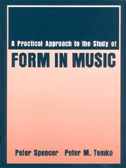“I liked it very much and appreciated the clear and brief explanations and the accessible musical examples.” — Lark Powers, East Central University
“I have long been searching for a book of this type. It covers the important points of structural analysis without the pedantic ramblings found in many texts.” — Michael Levi, College of St. Rose

215 pages, $56.95 list
0-88133-806-0
978-0-88133-806-5
© 1988
paperback
eBook availability
Similar Titles
A Practical Approach to the Study of Form in Music
Learning music’s organizing principles . . . Approaching the study of form as an exercise in perceiving the interaction of a number of discrete musical events, Spencer and Temko’s book embodies much more than a search for visual clues. Students of form develop perceptual tools that allow them to proceed from the aural experience to an understanding of the arch-principles upon which music is organized. The authors hold that the organizing principles of a given piece of music may be gleaned from studying the internal attributes that give a section its specific identity, the functional relations between sections, and the ordering of those sections.
Reactions
Part I. FUNDAMENTAL ANALYTICAL TOOLS
1. Structural Phenomena
2. Structural Units
3. Structural Functions
Part II. PRINCIPLES AND PROCEDURES
4. The Binary Principle
5. The Ternary Principles
6. Imitative Procedures
7. Variation Procedures
8. The Binary Principle: Sonata-Allegro Form
9. The Rondo Principle
10. Atypical Formal Organization
1. Structural Phenomena
2. Structural Units
3. Structural Functions
Part II. PRINCIPLES AND PROCEDURES
4. The Binary Principle
5. The Ternary Principles
6. Imitative Procedures
7. Variation Procedures
8. The Binary Principle: Sonata-Allegro Form
9. The Rondo Principle
10. Atypical Formal Organization